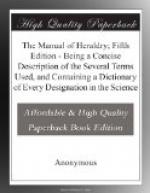The principal herald is Garter-King-at-Arms. It is his office to regulate the solemnities, and emblazon the arms of the sovereign, knights, and officers of the most noble order of the Garter. Garter-King-at-Arms likewise presides over all heraldic ceremonies of the Court. His crown of gold is formed with oak leaves, one shorter than the other, springing from a circlet of gold, having engraved upon it the words “MISERERE MEI DEUS.” His tabard, as principal herald, is of crimson velvet, splendidly embroidered with the arms of England.
Clarencieux and Norroy are called provincial kings-at-arms, the former regulating all things connected with Heraldry in the provinces south of the Trent; the latter in the provinces north of the Trent. They have likewise crowns; and though the office of herald is not of so much importance now as it was formerly, it is still considered a post of great honour and emolument.
There are eight heralds that are not kings-at-arms. Their tabards are of silk, embroidered with the royal arms. They are called York, Lancaster, Somerset, Richmond, Chester, and Windsor. George the First created a new herald called Hanover, and another called Gloucester.
The kings-at-arms, heralds, and pursuivants, form the Heralds’ College, by whom all matters connected with the coats of arms of every gentleman in the kingdom are arranged and determined.
HILTED. The handle of a sword tinctured.
[Illustration: Hilted]
Ex. Argent, a sword proper couped, hilted or.
[Illustration: HONOUR POINT]
HONOUR POINT. That part of the shield between the precise middle chief and the fess point. In the annexed example the large dot in the centre shows the fess point; the point within the letter D, the honour point. See p. 6. [CHAP. II.]
HORNED. This term is used to denote that the horn of a unicorn is of a different tincture from his body.
[Illustration: Horned]
Ex. Azure, three unicorns’ heads proper, erased, horned or.
HUMETTY. A term used to denote an ordinary, parts of which are couped or cut off, so that it does not touch the edges of the shield.
[Illustration: Humetty]
Ex. Argent, a fess humetty gules, between three mullets sable.
[Illustration: HURTS]
HURTS. Blue roundlets: the colour is expressed in the name; therefore the tincture is not otherwise named in emblazoning a coat of arms.
[Illustration: Spearhead imbued.]
IMBUED. Weapons spotted with blood are said to be imbued. The example shows a spearhead imbued.
IMPALED. Two coats of arms, conjoined paleways, in one shield.
[Illustration: Impaled]
Ex. Argent, a fess gules, impaled with argent, a bend azure. See p. 38. [CHAP. VI.]
INCRESCENT. The new moon, with her horns turned towards the dexter side of the shield.




